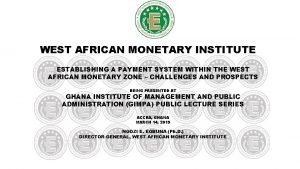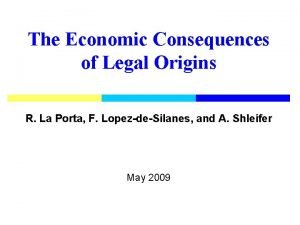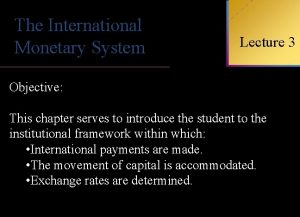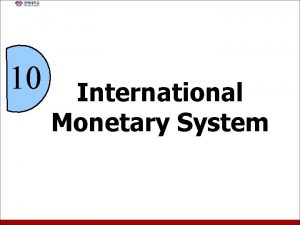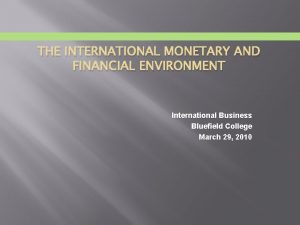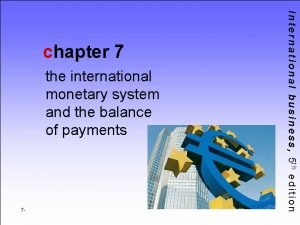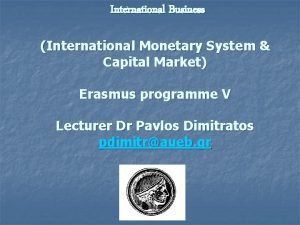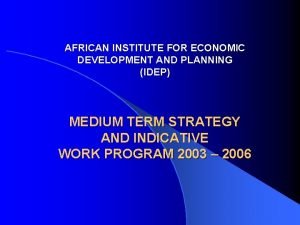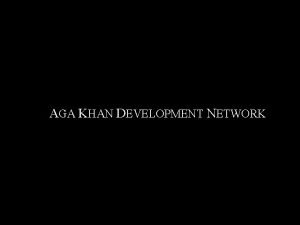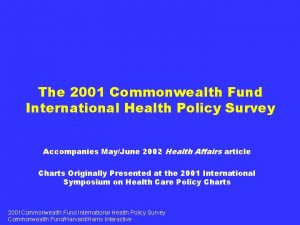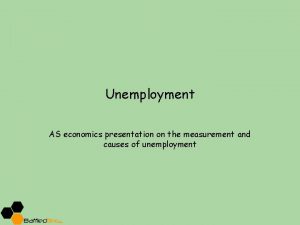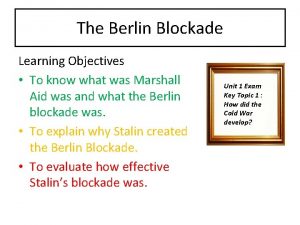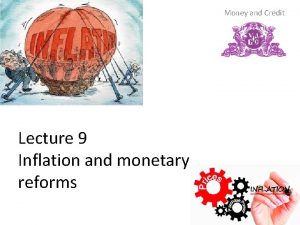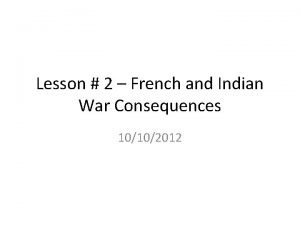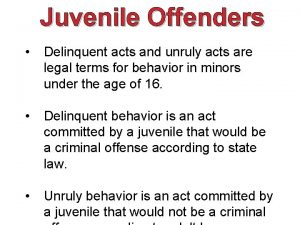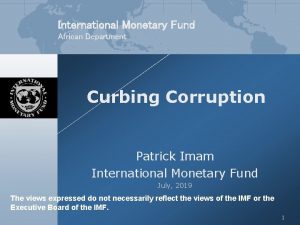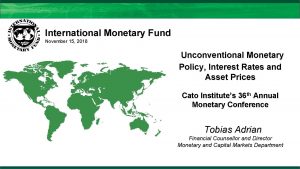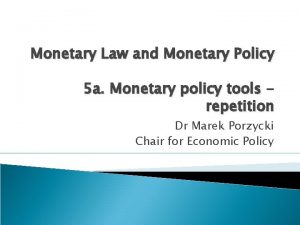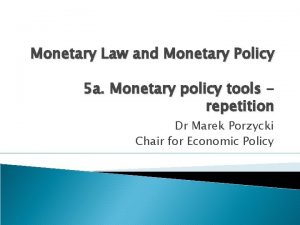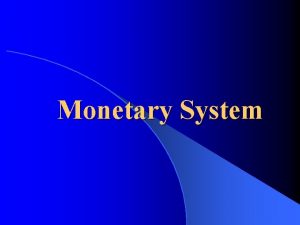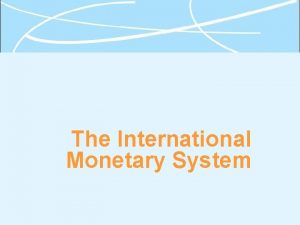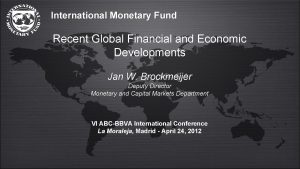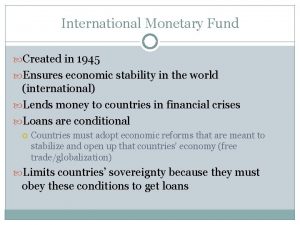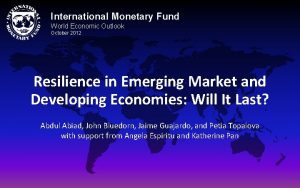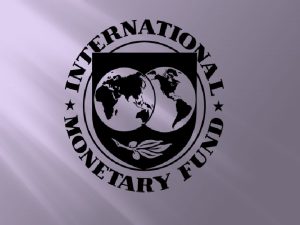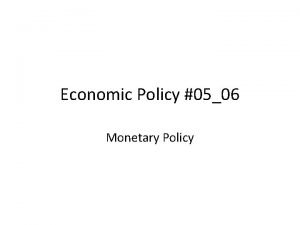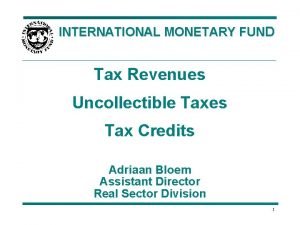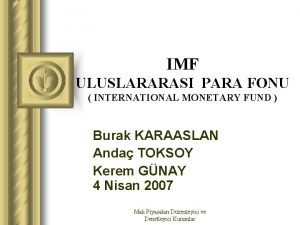International Monetary Fund African Department The Economic Consequences
































- Slides: 32

International Monetary Fund African Department The Economic Consequences of Conflict Patrick Imam IMF Resident Representative July 2019 The views expressed do not necessarily reflect the views of the IMF or the Executive Board of the IMF.

International Monetary Fund African Department CONTEXT

SUB-SAHARAN AFRICA REMAINS PRONE TO CONFLICT Sub-Saharan Africa: Geographical Distribution of Conflict-Related Deaths as a Share of Population 3

UPTICK IN CONFLICT IN RECENT YEARS Selected Regions: Share of Countries in Conflict Number of Countries in Conflict Sources: Uppsala GED and IMF Staff Calculations 4

WHAT DO WE DO? • Explore the economic consequences of conflicts in SSA: § Trends in conflict § Impact of conflict on macroeconomic growth § Channels through which conflict affects growth § Localized and spillover effects of conflict using nightlights data § Fiscal implications of conflict 5

International Monetary Fund African Department STYLIZED FACTS

INCREASE IN CONFLICT INTENSITY , THOUGH STILL BELOW THE 1990 S Total Conflict-Related Deaths Sub-Saharan Africa: Countries in High-Intensity Conflict Sources: Uppsala GED and IMF Staff Calculations 7

PARTLY DRIVEN BY AN INCREASE IN VIOLENCE IN THESAHEL REGION Sahel Region: Conflict-Related Deaths Distribution of Deaths in Sahel Region, 2011 -17 Sources: Uppsala GED and IMF Staff Calculations 8

OVERALL CONFLICT PREVALENCE HAS DECLINED … Sub-Saharan Africa: Share of Conflict Countries by Geographic Region and Economic Classification Geographic Regions Sources: Uppsala GED and IMF Staff Calculations 9

… AND THE NATURE OF CONFLICTS SEEMS TO HAVE CHANGED Sub-Saharan Africa: Share of Deaths in Different Types of Conflicts Terrorist Incidents Sources: Uppsala GED and IMF Staff Calculations 10

CONFLICTS IN SSA ARE HIGHLY PERSISTENT • Average duration of conflict in the region is about 4 years, with some countries involved in conflict for the entire sample period, 1989 -2017 Conflict Exit Probabilities • However, conflict persistence has generally declined, except for in the Sahel region where conflicts have become more persistent Sources: Uppsala GED and IMF Staff Calculations 11

CONFLICTS HAVE RESULTED IN LARGE NUMBER OF DISPLACED PEOPLE Persons of Concern from Sub-Saharan Africa Destination of Sub-Saharan African Refugees Source: UNHCR. 12

International Monetary Fund African Department IMPACT ON GROWTH

HOW DO CONFLICTS AFFECT ECONOMIC GROWTH ? Average Growth Rate by Country Type Conflict Episodes: Growth Rates and Cumulative GDP per capita Losses Source: IMF staff calculations. 14

GROWTH REGRESSIONS Emerging and Developing Countries: Impact on Growth of Increase in Conflict Intensity Sub-Saharan Africa: Effect on Growth of Different Conflict Intensity Levels Source: IMF staff calculations. 15

DOMESTIC FACTORS MATTER Impact of Conflict on Growth, Role of Institutions and Fiscal Fundamentals • Increase in conflict intensity in countries with strong institutions has a smaller effect on growth than in those with relatively weak institutions. • Countries with strong fiscal fundamentals (lower deficits or debt) also experience a smaller adverse effect of conflict on growth • Conflicts in economically important locations have a larger effect on growth than those in the periphery Source: IMF staff calculations. 16

EFFECT OF CONFLICTS ARE PERSISTENT Impulse Response of per-capita GDP in response to Shock to Conflict Intensity • Effect lasts at least five years after conflict onset • Onset of intensive conflict lowers output by 5 percent in the first year, with the cumulative effect over 5 years reaching 7. 5 percent Source: IMF staff calculations. 17

OUTPUT LOSS IN THE LONG TERM Output loss based on pre-conflict projections SSA: Index of Real GDP per-capita, Actual versus Forecast (Median value among conflict episodes) Output loss based on synthetic control method SSA: Index of Real GDP per-capita, Actual versus Synthetic Control (Median value among conflict episodes) Source: IMF staff calculations. 18

International Monetary Fund African Department CHANNELS

KEY CHANNELS OF TRANSMISSION • Investment • Trade (exports) • Productivity • Human capital 20

ECONOMIC AND SOCIAL DISRUPTION Impact of Conflict on Investment, Exports, and Productivity Impact of Conflict on Primary Enrollment Impact of Conflict on Maternal Deaths Source: IMF staff calculations. 21

International Monetary Fund African Department SPATIAL IMPACT THROUGH NIGHT-LIGHT DATA

CONFLICT AND NIGHTLIGHTS DATA • Red dots are conflict events between 1989 -2017 • Locate conflicts at state/province level • Confine night lights to states/provinces • Use “sum” of night lights as proxy for real GDP 23

NIGERIA : CONFLICT AND NIGHT -LIGHT ACTIVITY Panel A: Change in Number of Conflict. Related Deaths, 2008 -10 vs 2011 -2013 Panel B: Change in Night-Lights Growth, 2008 -10 vs 2011 -2013 Source: IMF staff calculations. 24

DIRECT AND SPILLOVER EFFECTS OF CONFLICT Sub-Saharan Africa Source: IMF staff calculations. Note: Impact of 100 deaths at state level on growth using night lights; direct and spillover effects. 25

International Monetary Fund African Department FISCAL IMPLICATIONS

FISCAL BALANCE DETERIORATES IN CONFLICTS Impact on Fiscal Variables of Intensive Conflict • Revenue: decreases because of disruption in economic activity, loss of tax base, and lower tax efficiency. • Expenditure: shift in composition away from capital spending to military expenditure. • Fiscal balance: average deterioration of about 2 percent of GDP • While public debt rises by about 9 ppts. Source: IMF staff calculations. 27

ZIMBABWE AND CONFLICTS • Zimbabwe has experienced low intensity conflict marked by periods of escalation and political violence. • • After independence in 1980, Robert Mugabe’s political party, the Zimbabwe African National Union-Patriotic Front (ZANU-PF), entrenched control over state institutions and the economy. The contest between ZANU-PF and the Movement for Democratic Change, post 1999, has led to violence and political tensions. As a result, political landscape continues to be characterized by mistrust and attempts to eliminate challenges to power. Land reform brought another element of conflict Conflict today remains rooted in disputes over national power, economic hardship and pre-colonial disputes which have not been resolved. 28

KEY CHANNELS OF TRANSMISSION IN ZIMBABWE • Investment • Productivity • Human capital • Trade (exports) 29

International Monetary Fund African Department CONCLUSIONS

KEY TAKEAWAYS • Conflicts have increased in SSA since 2013 after a decline through the 2000 s • Conflicts impose significant economic costs: • The impact on growth is large, persistent, and non-linear • Stems through a decline in investment, trade and productivity, and destruction of physical and human capital • Significant spillover effects on nearby regions • Negative fiscal implications 31

POLICY IMPLICATIONS • Imperative to prevent conflicts. • Mitigate the adverse consequences of conflicts through limiting the loss of human and physical capital, and trying to maintain wellfunctioning institutions. • Well-targeted and coordinated humanitarian aid and concessional external assistance to both the countries involved in conflict and those facing spillover effects can provide relief and create room to respond. 32
 International monetary fund apush
International monetary fund apush International monetary fund
International monetary fund International monetary fund
International monetary fund West african monetary institute
West african monetary institute The economic consequences of legal origins
The economic consequences of legal origins International monetary system
International monetary system Objectives of international monetary system
Objectives of international monetary system International monetary and financial environment
International monetary and financial environment International monetary and financial environment
International monetary and financial environment International monetary system
International monetary system International monetary system
International monetary system African institute for economic development and planning
African institute for economic development and planning Imprest and fluctuating
Imprest and fluctuating Fastoplast
Fastoplast China international fund management
China international fund management Commonwealth fund international health policy survey
Commonwealth fund international health policy survey Economic growth vs economic development
Economic growth vs economic development What is economic growth and development
What is economic growth and development Lesson 2 our economic choices
Lesson 2 our economic choices Structuralism in international relations
Structuralism in international relations Unintended consequences
Unintended consequences Costs of unemployment
Costs of unemployment Truancy consequences
Truancy consequences Okonkwo's attitude as he prepares to return to the clan is
Okonkwo's attitude as he prepares to return to the clan is Consequences of underage drinking
Consequences of underage drinking Berlin blockade consequences
Berlin blockade consequences What are the consequences of sin in genesis chapter 3
What are the consequences of sin in genesis chapter 3 Consequences of ww1
Consequences of ww1 Controlling measures of noise pollution
Controlling measures of noise pollution Consequences of inflation
Consequences of inflation Consequences
Consequences 7 delinquent behaviors
7 delinquent behaviors Causes inflation
Causes inflation



